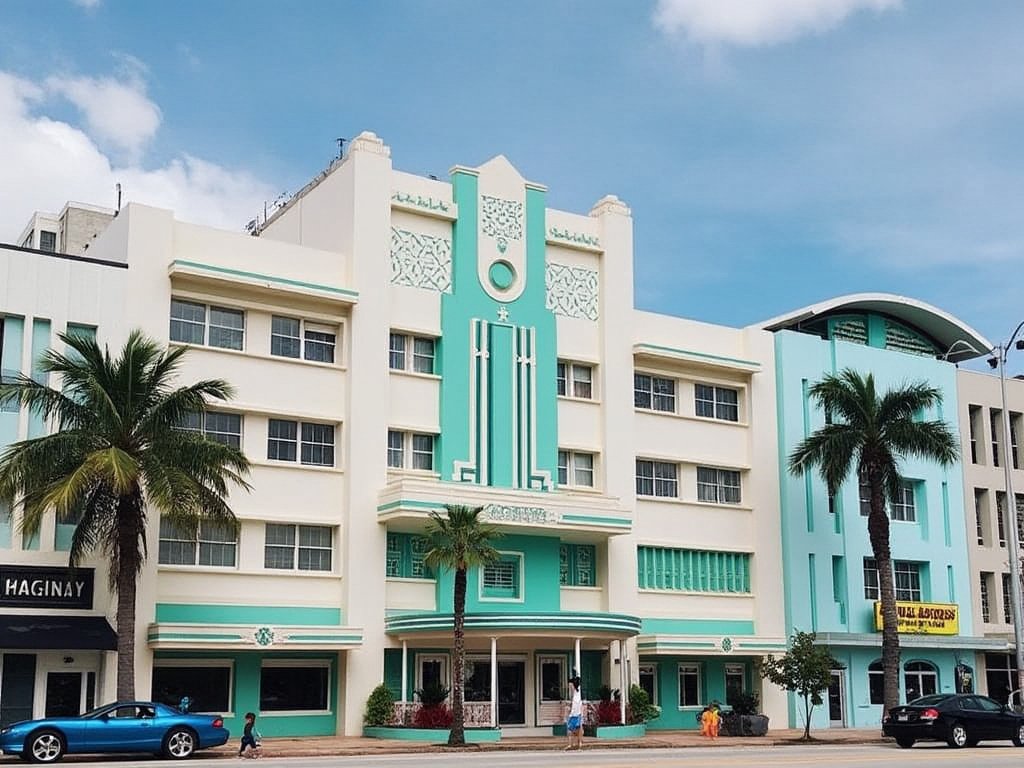In Miami, the sun-kissed beaches and rhythmic ocean waves create a scenic backdrop for a story of resilience and beauty that isn’t found in its natural landscapes alone. Walking through South Beach, it’s impossible to ignore the pastel-colored facades, geometric patterns, and neon lights that define the historic Art Deco District. These iconic structures aren’t just buildings—they are a testament to Miami’s cultural heart and an enduring symbol of the city’s ability to reinvent itself while honoring its past.
The Art Deco style, which gained prominence in the 1920s and 1930s, is more than an architectural movement; it is a living, breathing piece of Miami’s identity. With over 800 preserved buildings, Miami boasts one of the world’s largest collections of Art Deco architecture. From the porthole windows of the Essex House Hotel to the sleek curves of the Colony Theatre, this architectural style has become synonymous with Miami’s image, influencing everything from tourism to local pride. But how did this coastal city become the mecca of Art Deco design? And what challenges does it face in preserving this cultural treasure?
To understand the love affair between Miami and Art Deco, one must journey back to the early 20th century. In the 1920s, Miami was beginning to emerge as a tropical playground for the wealthy. Developers sought to transform the city into a paradise of leisure and glamour, a place that felt more modern and exotic than the austere cities of the North. Inspired by the International Exhibition of Modern Decorative and Industrial Arts held in Paris in 1925, architects in Miami adopted the Art Deco style. With its bold geometric shapes, vibrant colors, and playful motifs, the style seemed tailor-made for the city’s sunny disposition.
The 1930s brought a new wave of Art Deco buildings, many influenced by the Streamline Moderne variant of the style. This iteration, which emphasized curved edges and nautical themes, mirrored the sleekness of ocean liners and perfectly complemented Miami’s coastal environment. Hotels like the Ritz Plaza and the Delano rose to prominence, blending architectural sophistication with a carefree tropical flair. By the late 1930s, South Beach’s Ocean Drive was a showcase of Art Deco artistry, each building vying for attention with its unique design and glowing neon signage.
However, the journey of these structures hasn’t been without adversity. The mid-20th century brought changes to Miami that threatened the survival of its beloved Art Deco district. By the 1960s and 1970s, many of these buildings had fallen into disrepair. South Beach, in particular, became synonymous with crime and neglect, far removed from its glamorous heyday. Developers eyed the area for new high-rise condos and hotels, often bulldozing historic buildings in the name of progress. For a time, it seemed as if Miami’s architectural heritage might be lost forever.
This impending loss sparked a preservation movement led by passionate locals who recognized the cultural and economic value of Art Deco. One of the most prominent voices in this fight was Barbara Baer Capitman, who founded the Miami Design Preservation League (MDPL) in 1976. Capitman and her allies lobbied for the protection of South Beach’s Art Deco buildings, eventually succeeding in having the district added to the National Register of Historic Places in 1979. This designation marked a turning point, shielding many structures from demolition and encouraging restoration projects.
Today, Miami’s Art Deco District stands as a testament to the power of preservation and community action. The neighborhood attracts millions of visitors annually, drawn by its vibrant colors, unique aesthetic, and historical significance. Walking tours, museums, and festivals like Art Deco Weekend celebrate the district’s legacy, ensuring that it remains a living part of Miami’s culture rather than a relic of the past.
But the battle to preserve Miami’s Art Deco heritage is far from over. Rising sea levels, intensified storms, and the pressures of modern development pose significant challenges. Many Art Deco buildings are located within a few blocks of the ocean, making them particularly vulnerable to flooding and saltwater damage. Preservationists are now exploring innovative solutions to protect these structures, from elevating buildings to installing flood barriers. Yet, these measures require significant funding and community support, underscoring the importance of ongoing advocacy.
Another challenge comes from the evolving nature of Miami itself. As one of the fastest-growing cities in the United States, Miami faces relentless pressure to expand and modernize. New luxury developments often clash with preservation efforts, sparking debates about balancing growth with heritage. While some developers have embraced Art Deco as an inspiration for contemporary designs, others prioritize profit over preservation, threatening the district’s cohesive aesthetic.
Despite these obstacles, the future of Miami’s Art Deco legacy looks hopeful. The MDPL continues to champion preservation efforts, working closely with city officials, architects, and local businesses to ensure that the district remains vibrant and relevant. Meanwhile, Miami’s reputation as a global hub for art and culture has elevated the status of Art Deco beyond architecture, inspiring designers, filmmakers, and artists to incorporate its motifs into their work. From haute couture fashion shows to the bold murals of Wynwood, the Art Deco spirit resonates throughout Miami’s creative landscape.
The enduring appeal of Art Deco lies in its ability to evoke both nostalgia and innovation. For Miami, these buildings symbolize a golden era of glamour and possibility while serving as a reminder of the city’s resilience in the face of adversity. As climate challenges and urban development continue to shape Miami’s future, the preservation of its Art Deco heritage offers a blueprint for how history and progress can coexist.
For locals, the district is more than a tourist attraction; it’s a touchstone of identity. Each building tells a story of survival, creativity, and community. And for visitors, the Art Deco District offers a glimpse into a world where design meets destiny, where the past is preserved not in amber but in vibrant hues of pink, teal, and gold.
As you stroll down Ocean Drive or gaze up at the spire of the Cavalier Hotel, remember that these structures are more than decorative. They are the heartbeat of a city that refuses to let its history fade, standing tall against the tides of time and change. Miami may be a city of reinvention, but its Art Deco soul ensures that some things—like beauty, elegance, and the magic of the past—will never go out of style.





